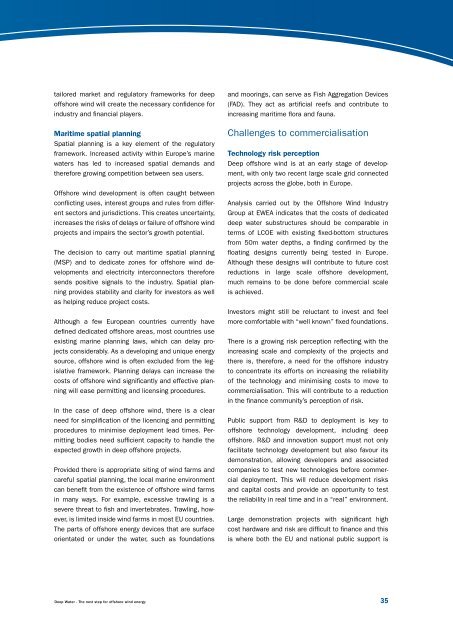Deep_Water
Deep_Water
Deep_Water
Create successful ePaper yourself
Turn your PDF publications into a flip-book with our unique Google optimized e-Paper software.
tailored market and regulatory frameworks for deep<br />
offshore wind will create the necessary confidence for<br />
industry and financial players.<br />
Maritime spatial planning<br />
Spatial planning is a key element of the regulatory<br />
framework. Increased activity within Europe’s marine<br />
waters has led to increased spatial demands and<br />
therefore growing competition between sea users.<br />
Offshore wind development is often caught between<br />
conflicting uses, interest groups and rules from different<br />
sectors and jurisdictions. This creates uncertainty,<br />
increases the risks of delays or failure of offshore wind<br />
projects and impairs the sector’s growth potential.<br />
The decision to carry out maritime spatial planning<br />
(MSP) and to dedicate zones for offshore wind developments<br />
and electricity interconnectors therefore<br />
sends positive signals to the industry. Spatial planning<br />
provides stability and clarity for investors as well<br />
as helping reduce project costs.<br />
Although a few European countries currently have<br />
defined dedicated offshore areas, most countries use<br />
existing marine planning laws, which can delay projects<br />
considerably. As a developing and unique energy<br />
source, offshore wind is often excluded from the legislative<br />
framework. Planning delays can increase the<br />
costs of offshore wind significantly and effective planning<br />
will ease permitting and licensing procedures.<br />
In the case of deep offshore wind, there is a clear<br />
need for simplification of the licencing and permitting<br />
procedures to minimise deployment lead times. Permitting<br />
bodies need sufficient capacity to handle the<br />
expected growth in deep offshore projects.<br />
Provided there is appropriate siting of wind farms and<br />
careful spatial planning, the local marine environment<br />
can benefit from the existence of offshore wind farms<br />
in many ways. For example, excessive trawling is a<br />
severe threat to fish and invertebrates. Trawling, however,<br />
is limited inside wind farms in most EU countries.<br />
The parts of offshore energy devices that are surface<br />
orientated or under the water, such as foundations<br />
and moorings, can serve as Fish Aggregation Devices<br />
(FAD). They act as artificial reefs and contribute to<br />
increasing maritime flora and fauna.<br />
Challenges to commercialisation<br />
Technology risk perception<br />
<strong>Deep</strong> offshore wind is at an early stage of development,<br />
with only two recent large scale grid connected<br />
projects across the globe, both in Europe.<br />
Analysis carried out by the Offshore Wind Industry<br />
Group at EWEA indicates that the costs of dedicated<br />
deep water substructures should be comparable in<br />
terms of LCOE with existing fixed-bottom structures<br />
from 50m water depths, a finding confirmed by the<br />
floating designs currently being tested in Europe.<br />
Although these designs will contribute to future cost<br />
reductions in large scale offshore development,<br />
much remains to be done before commercial scale<br />
is achieved.<br />
Investors might still be reluctant to invest and feel<br />
more comfortable with “well known” fixed foundations.<br />
There is a growing risk perception reflecting with the<br />
increasing scale and complexity of the projects and<br />
there is, therefore, a need for the offshore industry<br />
to concentrate its efforts on increasing the reliability<br />
of the technology and minimising costs to move to<br />
commercialisation. This will contribute to a reduction<br />
in the finance community’s perception of risk.<br />
Public support from R&D to deployment is key to<br />
offshore technology development, including deep<br />
offshore. R&D and innovation support must not only<br />
facilitate technology development but also favour its<br />
demonstration, allowing developers and associated<br />
companies to test new technologies before commercial<br />
deployment. This will reduce development risks<br />
and capital costs and provide an opportunity to test<br />
the reliability in real time and in a “real” environment.<br />
Large demonstration projects with significant high<br />
cost hardware and risk are difficult to finance and this<br />
is where both the EU and national public support is<br />
<strong>Deep</strong> <strong>Water</strong> - The next step for offshore wind energy 35


